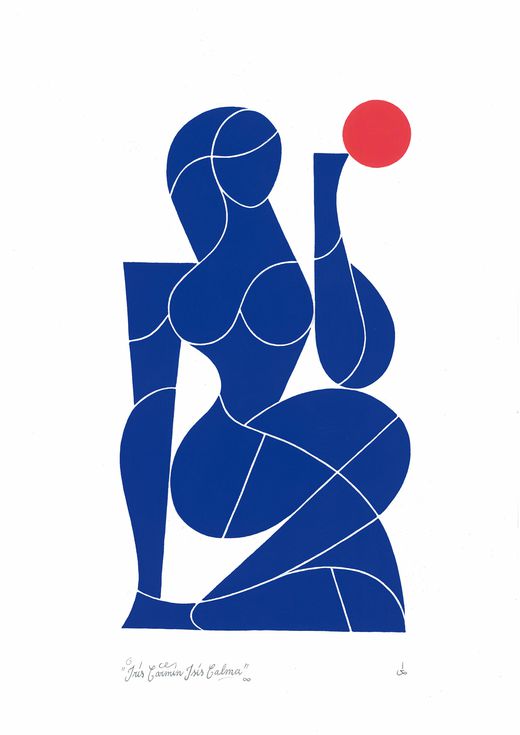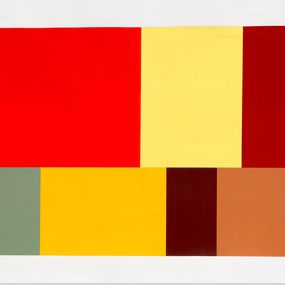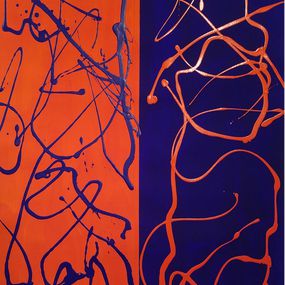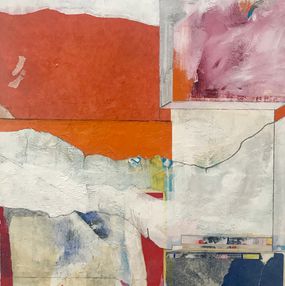

France
• 1978
51 followers
Biography
Born in Paris on December 30, 1978.
Influenced in equal measures by classical 20th century artists such as Modigliani and Léger, as by the Moroccan art of Zellige, (a form of highly decorative enameled terra cotta), Remed’s work has a unique, immediately recognizable quality in both its micro and macro manifestations.
Working at the conjunction of mathematics and calligraphy, seeking a harmonic purity combined with the flow, the energy of the line, Remed seeks to find truth through simplicity, to find a universal language of form and colour. Although now based in Madrid, Remed grew up in Lille alongside his close friend, and most common artistic collaborator 3TTMan (see pp.46-50). Following him firstly to after school art-classes and later to a college of the applied arts (where he studied “space-communication”), Remed was destined for a career in graphic design before a friend with whom he was studying introduced him to graffiti.
Two years on, and six months spent steadily decaying in front of a computer at a design agency, he quit his job after gaining an opportunity to work independently, teaching graffiti to children at various schools and social institutions (a role which can be seen to have come to a climax with his work at the Children’s Museum of the Arts in New York in 2011). Whilst Remed began to learn more about the history of the urban arts through this work, it was a chance meeting with the Algerian artist Mahjoub Ben Bella which became the first real turning point in his artistic journey.
As a first encounter with an artist who was living his life through the purity of his work, through a work unsullied by any commercial influence or even interest, Ben Bella gave Remed the belief to embrace his own ability, he thus starting to concentrate
more seriously on his artistic work from this point on. By the time he moved to Sao Paulo in 2006, Remed’s artistic style had begun to shape into a form we can now
clearly recognize.
Starting to produce more large scale murals, and developing a highly cosmological, highly spiritual visual language of his own, his work began to use a more heightened illustrative simplicity whilst at the same time developing a more keen complex narrativity. Whilst the Moroccan influence took hold through the fusion of geometric and calligraphic elements then (his figures almost disappearing within the vivid colours and flat patterning he had created), the intricate stories he wove into each of his images came to function almost like religious parables or folk legends, a densely embedded significance often overlooked through due to their decorative beauty.
Becoming equally obsessed with the relationship between mathematics and aesthetics, with the intertwined harmony of the world around him, Remed’s work can thus be seen to have become steeped in the balance and contrasts so prevalent within Islamic Art, a visual regime in which all parts of the image were involved in a
search for synchrony, where nothing was left to chance.
Yet while his aesthetic experimentations were emerging from a very personal space (his urge to paint functioning akin to a “diary, a notebook of inventions, or philosophical essay”), so to they were attempting to transcend the self in an attempt to reach others.
Attempting to form a shared dialect, a language able to traverse social and cultural values through the founding of an almost primordial visual regime, Remed was attempting to communicate the classic themes and dualities of existence – life and death, illness and health, good and evil – working between figuration and abstraction so as to find a shared ground with those who were around him.
Since returning to Madrid where he has now settled, Remed’s work has continued to refine, developing into what is now an inimitable style. Whilst producing ever increasing series of paintings inside then, Remed has still kept up a strong presence in the urban environment, tagging, albeit in a now highly experimental manner, inscribing philosophical calligraphic messages (often in chalk) onto city walls, etching into metal, as well as both pasting and painting his more complex designs throughout the city.
For Remed, all of these activities are as important as the other, each an opportunity for performative release as much as communal exchange, each a chance to rhyme with colour and form, an occasion for both experimentation and communication. For him, art is simply understood as a way of healing the soul, of curing the mind, as a form of very public, outward therapy.
It is a the blend of science and soul, a way to cope with pain and happiness, love and hate, light and darkness, a remedy for life itself.
Read more
Influenced in equal measures by classical 20th century artists such as Modigliani and Léger, as by the Moroccan art of Zellige, (a form of highly decorative enameled terra cotta), Remed’s work has a unique, immediately recognizable quality in both its micro and macro manifestations.
Working at the conjunction of mathematics and calligraphy, seeking a harmonic purity combined with the flow, the energy of the line, Remed seeks to find truth through simplicity, to find a universal language of form and colour. Although now based in Madrid, Remed grew up in Lille alongside his close friend, and most common artistic collaborator 3TTMan (see pp.46-50). Following him firstly to after school art-classes and later to a college of the applied arts (where he studied “space-communication”), Remed was destined for a career in graphic design before a friend with whom he was studying introduced him to graffiti.
Two years on, and six months spent steadily decaying in front of a computer at a design agency, he quit his job after gaining an opportunity to work independently, teaching graffiti to children at various schools and social institutions (a role which can be seen to have come to a climax with his work at the Children’s Museum of the Arts in New York in 2011). Whilst Remed began to learn more about the history of the urban arts through this work, it was a chance meeting with the Algerian artist Mahjoub Ben Bella which became the first real turning point in his artistic journey.
As a first encounter with an artist who was living his life through the purity of his work, through a work unsullied by any commercial influence or even interest, Ben Bella gave Remed the belief to embrace his own ability, he thus starting to concentrate
more seriously on his artistic work from this point on. By the time he moved to Sao Paulo in 2006, Remed’s artistic style had begun to shape into a form we can now
clearly recognize.
Starting to produce more large scale murals, and developing a highly cosmological, highly spiritual visual language of his own, his work began to use a more heightened illustrative simplicity whilst at the same time developing a more keen complex narrativity. Whilst the Moroccan influence took hold through the fusion of geometric and calligraphic elements then (his figures almost disappearing within the vivid colours and flat patterning he had created), the intricate stories he wove into each of his images came to function almost like religious parables or folk legends, a densely embedded significance often overlooked through due to their decorative beauty.
Becoming equally obsessed with the relationship between mathematics and aesthetics, with the intertwined harmony of the world around him, Remed’s work can thus be seen to have become steeped in the balance and contrasts so prevalent within Islamic Art, a visual regime in which all parts of the image were involved in a
search for synchrony, where nothing was left to chance.
Yet while his aesthetic experimentations were emerging from a very personal space (his urge to paint functioning akin to a “diary, a notebook of inventions, or philosophical essay”), so to they were attempting to transcend the self in an attempt to reach others.
Attempting to form a shared dialect, a language able to traverse social and cultural values through the founding of an almost primordial visual regime, Remed was attempting to communicate the classic themes and dualities of existence – life and death, illness and health, good and evil – working between figuration and abstraction so as to find a shared ground with those who were around him.
Since returning to Madrid where he has now settled, Remed’s work has continued to refine, developing into what is now an inimitable style. Whilst producing ever increasing series of paintings inside then, Remed has still kept up a strong presence in the urban environment, tagging, albeit in a now highly experimental manner, inscribing philosophical calligraphic messages (often in chalk) onto city walls, etching into metal, as well as both pasting and painting his more complex designs throughout the city.
For Remed, all of these activities are as important as the other, each an opportunity for performative release as much as communal exchange, each a chance to rhyme with colour and form, an occasion for both experimentation and communication. For him, art is simply understood as a way of healing the soul, of curing the mind, as a form of very public, outward therapy.
It is a the blend of science and soul, a way to cope with pain and happiness, love and hate, light and darkness, a remedy for life itself.
Nationality
Categories
Artistic movements
Themes
Discover the movements linked to Remed
Discover similar artists
Discover our selections of works by artists
Need help finding your favorite? Consult our selection pages made for you.
Need to know more?
What are their 3 main works?
What is Remed’s artistic movement?
The artistic movements of the artists are: Colorful Geometric Painters
When was Remed born?
The year of birth of the artist is: 1978













